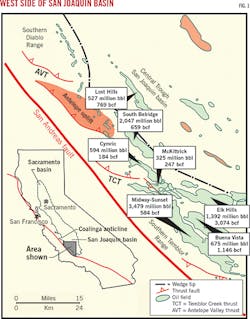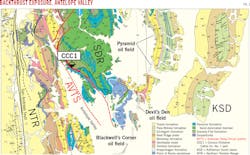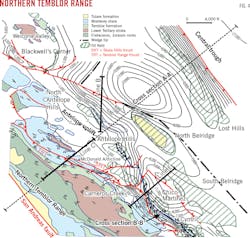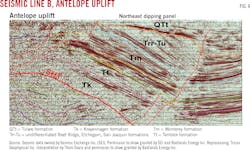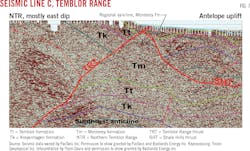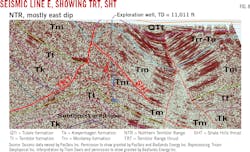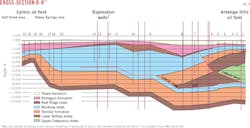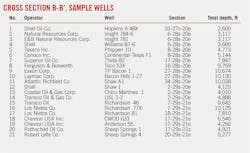Study shows evidence for untested large traps, San Joaquin basin, Calif.
Thomas Davis
Geologist
Ventura, Calif.
Recent exploration and renewed interest in the San Joaquin basin, and other California oil basins, has focused on unconventional shale plays, especially in the Monterey formation. Results have been disappointing. Drilling in the deeper portions of the San Joaquin basin, where the source units are thermally mature, has not overcome these disappointing results.1 2 3
Questions remain about the commercial viability of the Monterey formation as a resource play, and probably about the basin's other shale units as well. Unconventional shale's lack of success does not diminish the importance of these rich source rocks and their prolific petroleum systems for other play types. Traps containing migrated hydrocarbons (conventional plays) have been the most successful for the basin and for now provide the lowest risk and least expensive untested prospects.
The west side (WS) of the San Joaquin basin has one such newer conventional play that is the result of overthrusting associated with the late Cenozoic age fold-and-thrust structural style common to many of California's oil basins. Overthrusting increases prospective "running room" by repeating proven reservoir and source rock units, increases source rock burial and hydrocarbon maturity, and increases the number of untested subthrust anticlines and other concealed structural traps available to capture the migrated hydrocarbons.4 5
This article presents a structural model and conventional play concept for a portion of the WS that, if proven, raises its hydrocarbon potential by adding area containing untested large traps with known reservoir and source rock units.
WS is a folded and faulted belt that has produced and proven reserves totaling 11.7 billion bbl of oil as of 2005.6 It lies between the San Andreas fault and the relatively undeformed central trough of the basin and includes the Temblor Range and the southern Diablo Range (Fig. 1). Despite the great number of exploration wells along the WS, additional conventional oil discoveries are likely, due to rich source-rock units such as the Monterey, Tumey, and Kreyenhagen shales, and the structural and stratigraphic complexity of the area, offering a variety of trapping situations. An active and very prolific petroleum system helps this potential.7
Structural complexity and other seismic acquisition issues prevent capturing a clear image of much of the WS, but ironically it's the poor imaging that has allowed traps, even large ones, to remain untested. The conventional structural play in the San Joaquin, despite its years of success, has had less recent interest due to geologic perceptions that fewer prospects hold moderate to large traps. Mapping such prospects depends on using a realistic structural model to overcome the poor seismic imaging. Structural studies show a fold-and-thrust belt style involving a northeast-directed wedge model that better explains the late Cenozoic structural geometry and kinematic evolution of the WS than previous models.8 9 10
Wedge model interpretation
Geologists exploring in highly deformed areas such as the WS commonly rely on structural models to map, assist poor seismic reflection imaging, and develop prospects. The convergent wrench-fault model has dominated explanation of the the WS's large oil-trapping folds and their relationship to the nearby San Andreas transform fault for the past 50 years.11 12 Convergent wrench faulting is characterized by structural elements such as oblique-slip reverse faults that steepen with depth into a master strike-slip fault, positive flower structures, and a limited footwall area available for exploration (Fig. 2a).
A more realistic and data-based model of the WS's structure, and that of other areas of southern and central California with late Cenozoic convergent deformation, is a strain-partitioned transpressional belt, characterized by pure strike-slip along the San Andreas fault and small fold-and-thrust belts subject to pure shear on either side of the San Andreas fault.8 13 14 15 The fold-and-thrust belt interpretation also provides a more optimistic view of California's future petroleum potential. As the larger thrust sheets do not steepen, but flatten with depth and consequently conceal extensive footwall area with untested subbasins and structures.
Most fold and thrust belts, including the San Joaquin basin's WS, have a wedge-shaped, cross-sectional profile with a taper thinning towards the undeformed basin (Fig. 2b). The wedge grows basinward by internal thrust faulting and folding, and deformational progression is similar to the material being moved by a bulldozer or snowplow.16
Thrust faults within the wedge need not have the same direction of movement (vergence), and the resulting geometry is commonly characterized by a master backthrust (roof thrust) and a sole thrust with opposing vergence that creates a distinctive triangle zone (Fig. 2b). At the south end of the Diablo Range the northeast-dipping Antelope Valley thrust presents an excellent surface exposure of a backthrust located along the top of the basinward-directed wedge forming the WS (Fig. 3). Mapping shows that other large backthrusts are present along other portions of the WS; for instance, the Temblor Creek thrust in the Temblor Range, and the Waltham Canyon fault, west of Coalinga anticline in the Diablo Range (Fig. 1).8
The wedge model was first proposed in 1988 to explain the structural development of the northern portion of the WS, and the 1983 Coalinga earthquake (moment magnitude = 6.5) and its relationship to the Coalinga anticline (Fig. 1).8 9 In the Coalinga area the wedge creates a triangle-zone geometry with a subthrust anticline that involves mostly Cretaceous and Jurassic rocks with little oil potential. This article applies the wedge model to the Antelope uplift portion of the WS present between the northern Temblor Range and North Belridge oil field (Fig. 4). At the Antelope uplift the wedge involves Tertiary rocks with known source and reservoir units, making the uplift more prospective than the Coalinga area.
Antelope uplift structure
The Antelope uplift is an area of lower Tertiary strata exposed at the surface or present in the shallow subsurface, as shown by numerous shallow oil and gas wells and seismic reflection surveys (Fig. 4). The structural geometry and origin of the uplift has rarely been questioned despite its great size, structural relief, and dissimilarity to the nearby large oil-trapping anticlines. This article presents a regional cross section that uses fault-ramp folding such as fault-bend and fault-propagation folds, and cross-section balancing constraints to make an interpretation of the Antelope uplift and the WS (Fig. 5a).17 18 19 20
The cross-section interpretation, while not unique and untested by drilling, is valid as it can be retrodeformed, and shows the possible structural geometry beneath the uplift and its untested hydrocarbon potential (Fig. 5b). There is no evidence of strike-slip faults intersecting the cross-section line lying east of the San Andreas fault, which allows 2D restoration of the strata to their undeformed geometry in the direction of convergent strain (along the cross section line) as shown by fold axes and thrust faults. Restoration of the cross-section and matching the hanging wall and footwall ramps and flats test the validity of this interpretation. The cross-section integrates several reprocessed 2D seismic lines, well data, and surface geology (Fig. 4). Contouring the top of the Temblor formation shows the broad crest of the uplift and its northern, eastern and southern limbs. The west limb of the uplift is a regional synform, cored with Monterey formation and lying along the foothills of the northern Temblor Range.
Upper Tertiary and Quaternary strata are absent or thin across the Antelope uplift as a result of late Cenozoic folding and erosion, and the uplift lies within an earlier and broader uplifted block-i.e., the Antelope Valley peninsula-whose Oligocene to early Miocene history is recorded by nondeposition, erosion, and stratal onlap.21
Seismic Line B shows detail of the northeast-dipping limb of the Antelope uplift and its large amount of structural relief. Regional mapping of the limb show it is a part of a large structure that involves much of the upper crust, and is more important to the development of the WS than the small faults that cross the uplift's crest and toe.
Line B also shows that the folding and uplift involves strata as young as late Miocene, and folding and uplift occurred during the latest Miocene and Pliocene time and before deposition of the relatively unfolded Quaternary-age Tulare formation. The northeast-dipping limb formed a deformational front that developed before both the Quaternary-age anticlines at Lost Hills and North and South Belridge, which have a different geometry and smaller size than the older Antelope uplift (Figs. 4 and 5a). The leading edge of the pre-Quaternary deformational front, which lies along the base of the limb, is interpreted to lie above the wedge tip (WT) as shown in the generalized model (Fig. 2b). The absence of significant pre-Quaternary deformation to the northeast of the uplift limits the possible fault-ramp fold and fault-slip configurations that could make the uplift, which in the cross-section is interpreted to be the back of a fault-bend fold developed in the hanging wall of a roof thrust called the Shale Hill thrust (SHT).
Line C crosses the northern Temblor Range where the surface geology is dominated by a northeast-dipping panel of strata of Cretaceous through Miocene age (Fig. 4). Seismic Line C reveals a large panel of southwest-dipping strata directly below the northeast-surface dip (Fig. 7). This abrupt change in dip is interpreted to be a large southwest-dipping convergent fault referred to as the Temblor Range thrust (TRT). The surface and subsurface geology constrain the shallow part of the TRT to the trough of the regional synform that is located along the foothills of the Temblor Range. Similarly the northeast-dipping SHT is restricted from reaching the surface along the synclinal trough, and the opposing thrusts form an untested triangle zone capped by Monterey formation. Field examinations of the syncline show its trough is complexly faulted with no bedding continuity between opposing limbs, and likely a zone for TRT and SHT to "daylight" and juxtapose the Monterey formation, originally deposited miles apart.
The western portion of Line E also shows the northeast-dipping panel of strata that dominates the northern Temblor Range, and southwest-dipping reflectors at depth are separated by the TRT (Fig. 8). The line lies south of the portion of the Antelope uplift dominated by shallow, lower Tertiary strata (Fig. 4). Along the eastern portion of Line E the surface and shallow subsurface geology consist of a thick section of folded and faulted Monterey formation. The line reveals the triangle zone formed beneath the TRT and SHT and the opposing dips of a large subthrust anticline. A nearby exploration well drilled in 1946 to nearly 11,000 ft and projected into the line reached the very top of Temblor formation and had numerous oil shows. Well core dips are consistent with the wells drilled into the northeast limb of the anticline.
Source, reservior rock indication
The stratigraphy of the triangle zone below the SHT and TRT can be postulated by two methods showing the zone should involve known source and reservoir rocks of late Cretaceous through Miocene age:
• Geologic units within the footwall block have about the same structural relief as the undeformed units to the east in the central trough once slip is removed along the Quaternary age Lost Hills thrust (Fig. 5b).
• The stratigraphy, including the producing oil reservoirs, of the Cymric oil field can be mapped northward using deep-well data and strike seismic lines (Fig. 9 and accompanying table).
These geologic units plunge northward, beneath the lateral ramps forming the southern edge of the Antelope uplift, and into the triangle zone. Other seismic lines plus a few exploration wells show the triangle zone and subthrust areas beneath the Antelope uplift are folded into anticlines and synclines as would be expected in this convergence area (Fig. 8). Untested subthrust anticlines could have 1,000-10,000 acres of closure based on structural modeling of the numerous reprocessed 2D seismic lines (most not shown here). For comparison, Elk Hills oil field-an anticlinal trap-has a maximum area of about 21,170 acres with production and reserves totaling 1,392 million bbl of oil.
The subthrust area presented here adds about 18% to that portion of the WS capable of holding large traps (the footwall area of the uplift is approximately 80,000 acres while the WS trend of large oil fields is about 440,000 acres).
The exploration potential of the footwall block is further enhanced by deep thrust burial of known source rock units that should provide sufficient hydrocarbon maturity from below the uplift and a short migration pathway from kitchen to traps. The wedge model can be applied to other portions of the WS, given the presence of back thrusting in the Temblor Range and other areas of the west side, and such an approach should provide even more prospective area for large untested traps along the WS of San Joaquin basin.
Acknowledgments
The author would like to recognize and thank Seismic Exchange Inc., Pacific Seismic Inc., and Badlands Energy Inc. for granting permission to show data and interpretations. Reprocessing of the 2D seismic was done by Tricon Geophysical, Inc.
References
1. Hughes, J.D., "Drilling California: A reality check on the Monterey shale," Post Carbon Institute, Dec. 2, 2013, p. 58.
2. Burzlaff, A.A. and Brewster, D.P., "Unconventional oil from California's Monterey Formation-exploration results," #SPE-169508-MS, presented at Society of Petroleum Engineers Western North America and Rocky Mountain Joint Conference and Exhibition, Denver, Apr. 15-18, 2014.
3. Schwartz, D., "Recent characterization of the Monterey Formation in the San Joaquin basin (abstract)," Pacific Section AAPG Convention, Oxnard, Calif., May 4, 2015.
4. Davis, T.L., Lagoe, M.B., Bazeley, W.J.M., Gordon, S., McIntosh, K., and Namson J.S., "Structure of the Cuyama Valley, Caliente Range, and Carrizo Plain and its significance to the structural style of the southern Coast Ranges and western Transverse Ranges," in W.J.M. Bazeley, ed., "Tertiary tectonics and sedimentation in the Cuyama basin, San Luis Obispo, Santa Barbara, and Ventura Counties, California: Pacific Section," Society of Economic Paleontologists and Mineralogists, Book 59, 1988, pp. 141-158.
5. Davis, T.L., Namson, J.S., and Gordon, S.A., "Ventura Basin Oil Fields: Structural Setting and Petroleum System: Field guidebook for Trip #5," Pacific Section AAPG Meeting, Oxnard, Calif., May 2-8, 2015.
6. Tennyson, M.E., "California Division of Oil, Gas, and Geothermal Resources online data," US Geological Survey, 2015.
7. Scheirer, A.H., ed. "Petroleum systems and geological assessment of oil and gas in the San Joaquin basin province, California," Professional paper No. 1713, US Geological Survey, San Joaquin Basin Province Assessment Team, 2007.
8. Namson, J.S. and Davis, T.L., "Seismically active fold and thrust belt in the San Joaquin Valley, California," Geological Society of America Bulletin, Vol. 100, February 1988, pp. 257-273.
9. Namson, J.S., Davis, T.L., and Lagoe, M.B., "Tectonic history and thrust-fold deformation style of seismically active structures near Coalinga," in Rymer, M.J., and Ellsworth, W.L., eds., "The Coalinga California earthquake of May 2, 1983: U.S.Geological Survey Professional Paper 1487," 1990, pp. 79-96.
10. Davis, T.L., Namson, J.S., and Gordon, S.A., "Structure and hydrocarbon exploration in the Transpressive basins of southern California," in Abbott, P.L., and Cooper, J.D., eds., "Field conference guide 1996, Pacific Section, Society of Economic Paleontologists and Mineralogists," Pacific Section, American Association of Petroleum Geologists Guidebook, Vol. 73, 1996.
11. Wilcox, R.E., Harding, T.P., and Seely, D.R., "Basic Wrench Tectonics," American Association of Petroleum Geologists Bulletin, Vol. 57, No. 1, 1973, pp. 74-96.
12. Harding, T.P., "Tectonic significance and hydrocarbon trapping consequences of sequential folding synchronous with San Andreas faulting, San Joaquin Valley, California," American Association of Petroleum Geologists Bulletin, Vol. 60, No. 1, 1976, pp. 356-378.
13. Mount, V.S. and Suppe, J., "State of stress near the San Andreas fault: implications for wrench tectonics" Geology,Vol. 15, No. 12, December 1987, pp. 1143-1146.
14. Zoback, M. D., "New evidence for the state of stress on the San Andreas fault system," Science, Vol. 238, No. 4830, Nov. 20, 1987, pp. 1105-1111.
15. Namson, J.S. and Davis, T.L., "Structural transect of the western Transverse Ranges, California: implications for lithospheric kinematics and seismic risk evaluation," Geology, Vol. 16, August 1988, pp. 675-679.
16. Fossen, H., "Structural Geology," Cambridge University Press, Cambridge, UK, August 2010, pp. 463.
17. Suppe, J. "Geometry and kinematics of fault-bend folding," American Journal of Science, Vol. 283, Sep. 1, 1983, pp. 684-721.
18. Mitra, S., "Fault-Propagation Folds: Geometry, Kinematic Evolution, and Hydrocarbon Traps," American Association of Petroleum Geologists Bulletin, Vol. 74, 1990, pgs. 921-945.
19. Marshak, S., and Woodward, N., "Introduction to cross-section balancing," in Marshak, S., Mitra, G., eds., "Basic Methods of Structural Geology: Englewood Cliffs, New Jersey," 1988, pp. 303-302.
20. Mitra, S., "Balanced structural interpretations in fold and thrust belts, in S. Mitra, and G.W. Fisher, eds., "Structural Geology of Fold and Thrust Belts," Johns Hopkins University Press, Sep. 1, 1992, pp. 53-77.
21. Pence, J.J., "Sedimentology of the Temblor Formation in the northern Temblor Range, California," in Graham, S.A., ed., "Geology of the Temblor Formation, Western San Joaquin Basin, California" Pacific Section Society of Economic Paleontologists and Minerologists, Vol. 44, pp.19-34, 1985.
Manuscripts welcome
Oil & Gas Journal editors are happy to consider for publication manuscripts about exploration and development, drilling, production, pipelines, LNG, and processing (refining, gas processing, and basic petrochemicals). These papers may be highly technical in nature and appeal or they may analyze oil and natural gas supply, demand, and markets. OGJ accepts manuscripts submitted exclusively to it or those adapted from oral and poster presentations. An Author Guide is available at www.ogj.com; click "Home," then "Submit an article." Or, contact Managing Editor-Technology ([email protected]; 713/963-6211; or, fax 713/963-6282), Oil & Gas Journal, 1455 West Loop South, Suite 400, Houston TX 77027 USA.

